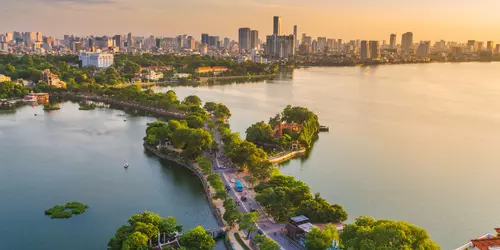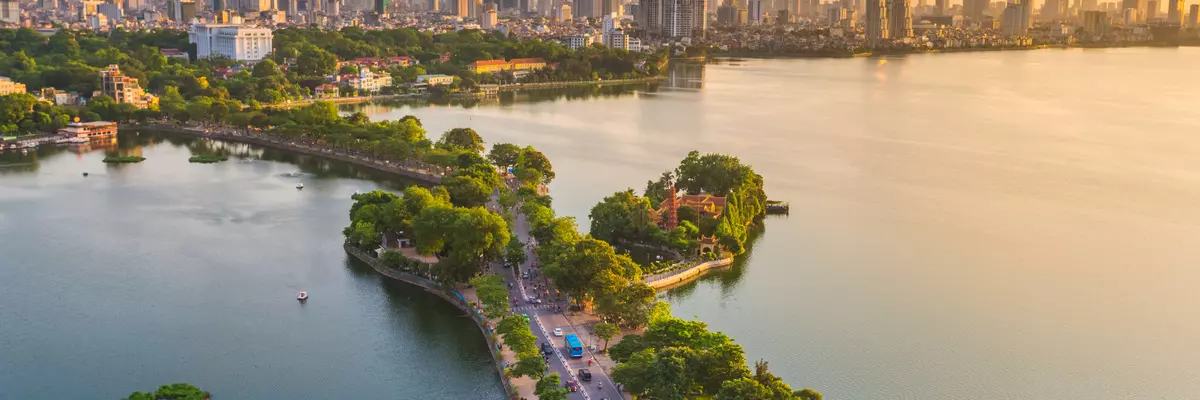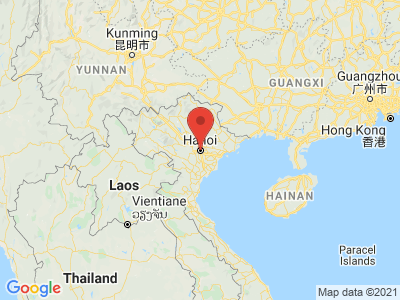Climate Table Hanoi
Jan | Feb | Mar | Apr | May | Jun | Jul | Aug | Sep | Oct | Nov | Dec | |
|---|---|---|---|---|---|---|---|---|---|---|---|---|
| Max. Temperature | 20° | 21° | 23° | 27° | 32° | 33° | 33° | 32° | 31° | 29° | 26° | 22° |
| Min. Temperature | 14° | 15° | 17° | 21° | 24° | 25° | 26° | 25° | 24° | 22° | 18° | 15° |
| Sun Hours | 3 | 2 | 2 | 3 | 6 | 5 | 6 | 6 | 6 | 6 | 5 | 4 |
| Water Temperature | 20° | 19° | 20° | 23° | 27° | 29° | 29° | 29° | 29° | 28° | 25° | 22° |
| Rain Days | 5 | 7 | 11 | 9 | 13 | 11 | 12 | 12 | 10 | 7 | 5 | 3 |
The climate year of Hanoi
Hanoi, the capital of Vietnam, has about 6.5 million inhabitants and is located in the delta of the Red River in northern Vietnam. The Vietnamese name of the city is derived from its geographical location: Hanoi is the "city within the rivers". The Red River carries a high sediment content, equivalent to about 1.5 kg per cubic meter of water. Due to the deposition of sediments, the delta of the Red River is constantly changing and enlarging. In addition, flooding is more frequent and water volumes fluctuate greatly and are difficult to calculate. Climatically, Hanoi is in a subtropical location. In summer, humid and warm winds blow from the direction of the sea, while in winter, dry and cool winds from the direction of the continent prevail. The climate is influenced by the monsoon. Summers are warm and characterized by high humidity. Large amounts of rainfall, especially in the summer months, also characterize the monsoon climate prevailing in Hanoi. In such a climate thrives its own vegetation, the monsoon forest, which shapes the region culturally and economically.
General information about Hanoi
As the oldest surviving capital of Southeast Asia, Hanoi traces its origins to the Than Long Citadel, which is documented as having been founded in 1010. The remains of the citadel still exist today, and its central area was included in UNESCO's World Heritage List in 2010. The Temple of Literature with its collection of 82 stelae also received UNESCO's attention as a World Heritage Site. Worth seeing is the Old Quarter of Hanoi, especially the Quarter of the 36 alleys. Also worth seeing is Hoan Kiem Lake, created by a backwater of the Red River, which once separated the French colonial quarter from Old Hanoi. Once used for naval parades and with direct access to the Red River, Hoan Kiem Lake has been partially filled in over the past two centuries and is still around 700 meters long today.
Tourism Hanoi
The hot and humid summer brings high rainfall from May to September. In May and September, these are 180 and 130 mm, respectively, and in June, July and August, values between 239 and 318 mm are reached. In eight out of twelve months, the amount of precipitation is higher than the evaporation, which is why it is called a semi-humid climate. Summer temperatures range from 24 to almost 33 degrees Celsius. About half of each summer month is characterized by rainy days. In the fall, temperatures slowly drop below the 20-degree mark, and the lowest winter temperatures are measured in January, with a lower limit of 13.7 degrees Celsius, which is clearly in the mild range. The annual average humidity is 80.6%. At 85% each, it is highest in spring, more precisely in March and April. The annual average water temperature is a pleasant 25 degrees Celsius and only falls just below the 20-degree mark once in February.


